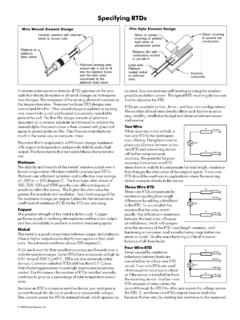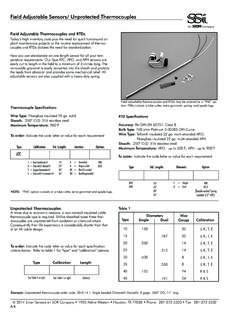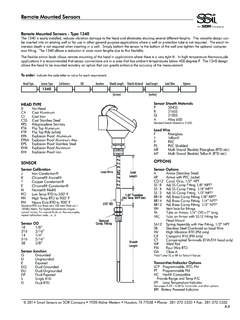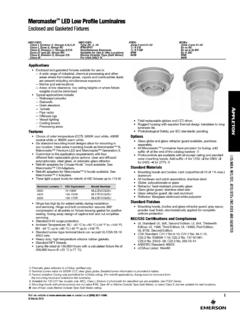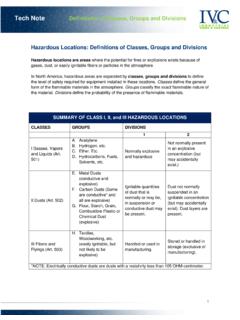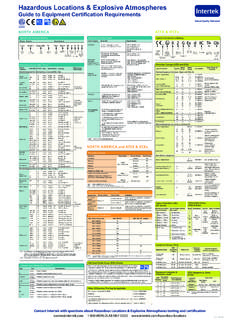Transcription of Specifying Temperature Sensors in Hazardous Areas
1 Specifying Temperature Sensors in Hazardous Areas A great concern to those who specify instruments is the safety of In reviewing the two Areas the probability of an explosion is the installation in Hazardous Areas . This guide will help the user more prevalent where explosive gases or dust are present in the define these locations and specify the proper sensor enclosure in process. Consequently Division I is defined as a Hazardous accordance to nationally accepted standards. location by standard institutions. The following list of acronyms are a sampling of the testing Today's instrumentation is more consistent and reliable than laboratories and standard institutes in North America that deal instruments used a decade ago, greatly reducing the chances of with standards and testing of materials used in Hazardous Areas .
2 A spill or process upset. Also specifications that call for non ANSI American National Standards Institute redundant technologies to prevent process upsets like spills have CSA Canadian Standards Association reduced the possibility of catastrophic occurrences in Division II. FM Factory Mutual Research Corporation Areas . Although Division II Areas are classified as nonhazard- I. S. Intrinsically Safe ous, for safety reasons many users prefer to use Division I. ISA Instrument Systems and Automation products in Division II Areas . In general because of the low NEC National Electric Code energy produced, non passive devices such as thermocouples NEMA National Electrical Manufacturers Association and RTDs should be safe in Division II Areas .
3 NFPA National Fire Protection Association UL Underwriters Laboratories In summary there are three methods of protection for tempera- ture Sensors in Division I Areas . They are: This guide is not intended to define Hazardous locations. Explosion proof housings However it will provide insight to sensor enclosures designed to Intrinsically safe loops function in Hazardous Areas . In North America the NEC divides Purged or safe instrument air flammable gases in to three classes: Gases This guide has pretty much described the Hazardous area and Dusts the following are the enclosures (heads) available from Smart Fibers Sensors along with the NEMA rating and the Areas that we recommend their use: The classes are further divided into groups.
4 The groups are organized by the explosive potential of the material within the group. The following table lists the class with an example of Explosion Proof some of the materials in the group. For use in: Class I. Class I: Group A: Acetylene Division I. Flammable gases Group B: Hydrogen, butadiene, Groups B, C, and D. and vapors ethylene oxide, propylene oxide Class II. Group C: Ethylene, coke oven gas, Division I. diethyl ether, dimethyl ether Groups E, F, and G. Group D: Propane, acetone, alcohols, ammonia, benzene, butane, ethane, ethyl acetate, gasoline, heptanes, hexanes, methane, octanes, pentanes, toluene.
5 Class II: Group E: Metal dust Combustible dusts Group F: Coal, coke dust Group G: Grain, plastic dust Class III: Wood flyings, paper fibers, cotton fibers NEMA - 4. Combustible flyings and fibers The third and final consideration of the standards is the prob- ability of the presence of the materials as identified by the groups that are incorporated into the three classes. This area is broken down into two separate Divisions. Division identification is thorough and complicated but basically subscribes to the following guidelines: NEMA - 4X. Division I: Areas where Hazardous materials may be present under normal operating conditions Division II: Areas where Hazardous materials may become present due to leaks, process upsets or failures 2003 Smart Sensors , Inc.
6 13. NEMA Protection Ratings In North America, Equipment can be classified per the National Electrical Manufacturer's Association (NEMA) Enclosure Classifications. NEMA is a nonprofit trade organization composed of mainly manufacturers of electrical apparatus. NEMA. created voluntary standards for electrical enclosures. These classifications describe the environment in which the product can be used due to the protection the enclosure provides. ( Enclosure includes electrical and mechanical connections and external adjustments.) Among others, NEMA classifies enclosures based on the effects of external icing, rust and corrosion, or contami- nation from oil and coolants.
7 Type 1 General Purpose Indoor accidental contact will not corrode Type 2 Drip-proof Indoor limited amounts of falling water and dirt will not corrode Type 3 Dust-tight, rain-tight Outdoor windblown dust, rain, sleet, and undamaged by external ice formation Type3R Dust-tight, rain-tight Outdoor same as type 3 above, plus diverts water from live parts, provision for drainage, will not corrode Type 3S Dust-tight, rain-tight Outdoors same as type 3 above, operation of external mechanism when ice laden, will not corrode Type 4 Water-tight, dust-tight Indoor/Outdoor windblown dust and rain, splashing water, and hose directed water, undamaged by ice formation, will not corrode Type 4X Water-tight, dust-tight Indoor/Outdoor same as type 4 above, plus corrode resistant, will not corrode Type 5 Dust-tight Indoor dust and falling dirt, will not corrode Type 6 Water-tight/dust-tight Indoor/Outdoor temporary entry of water during limited submersion (6ft/2m for 30.)
8 Min), undamaged by formation of ice, will not corrode Type 6P Water-tight/dust-tight Indoor/Outdoor same as type 6 above plus prolonged submersion, will not corrode Type 7 Explosion proof/Class I Groups A, B, C, D Indoor Hazardous Locations: Protection against corrosive effects of liquids and gases Type 8 Explosion proof/Class I Indoor/Outdoor Hazardous Locations: protection against corrosive effects of liquids and gases; contacts or connections immersed in oil Type 9 Explosion Proof/Class II. Groups E or G Indoor Hazardous Locations: dust-tight, Hazardous dust Type 10 Hazardous Locations Indoor MSHA Mine Safety and Health Adm.
9 Per 30 , Part 18. Type 11 Oil-tight/Corrode Indoor protection from corrosive effects of gases and liquid dripping, seepage and external condensation or corrosion, oil immersion Type 12 Oil-tight/Dust-tight Indoor fibers, lint, dust and light splashing, seepage and dripping condensation or non-corrosive liquids Type 12K Indoor same as type 12 above, enclosure has knockouts Type 13 Oil-tight/Dust-tight Indoor dust, spraying of water, oil and corrosive coolant, oil resistant gaskets The final area for discussion regarding protection in Hazardous No explosion proof housings are required in intrinsically safe Areas is intrinsically safe loops.
10 Temperature loops, consequently this can result in a significant cost savings to the user, However since most receiving instru- Intrinsically safe equipment is defined as equipment and wiring ments are AC powered, they can release stray voltage through which is incapable of releasing sufficient electrical or thermal the instrument wire to the field sensor . The use of Zener barriers energy under normal or abnormal conditions to cause ignition prevents explosions due to this scenario and certifies the loop as of a specific Hazardous atmospheric mixture in its most easily intrinsically safe. ignited concentration.

